Sustainable Marketing Report: Tengri's Strategies and Analysis
VerifiedAdded on 2023/01/16
|9
|2699
|22
Report
AI Summary
This report provides a comprehensive analysis of Tengri, a London-based clothing company specializing in sustainable apparel. The report begins with a background of the company, outlining its commitment to ethical sourcing and environmental consciousness. It then delves into Tengri's marketing mix, examining its product offerings (yak wool clothing), premium pricing strategy, distribution channels, and promotional activities. The core of the report analyzes Tengri's adherence to sustainable marketing principles, including its use of natural resources and innovative waste reduction methods. Furthermore, the report evaluates areas for improvement in Tengri's sustainability practices, such as eliminating the use of Angora fur and enhancing customer engagement. It also synthesizes the marketing mix theory, demonstrating its application in Tengri's operations. A competitive analysis is conducted, comparing Tengri's positioning against competitors like Premier Textiles and Wool UK, highlighting Tengri's strengths in quality and sustainability. Finally, the report concludes by summarizing Tengri's strong sustainable marketing model and offering recommendations for continued improvement.
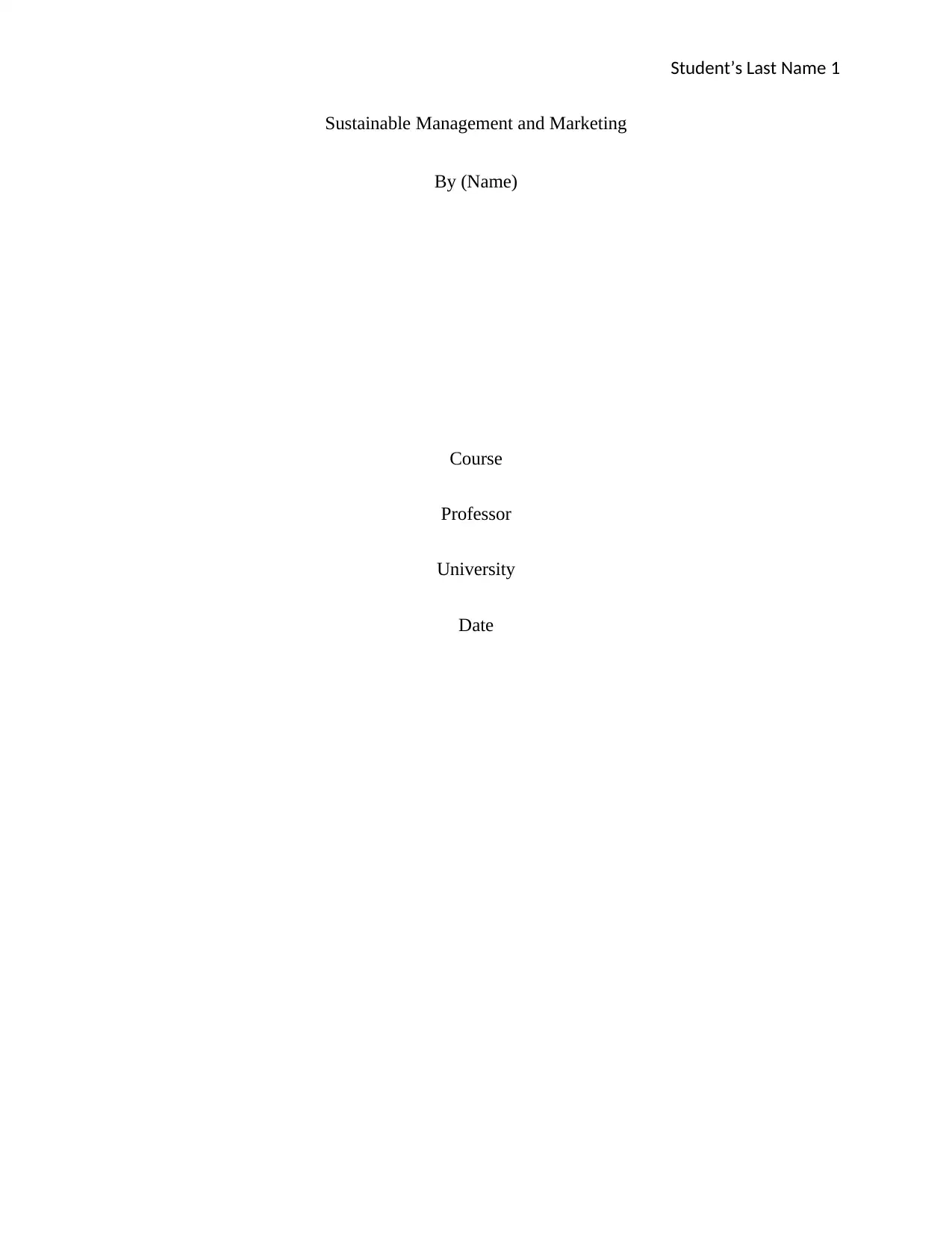
Student’s Last Name 1
Sustainable Management and Marketing
By (Name)
Course
Professor
University
Date
Sustainable Management and Marketing
By (Name)
Course
Professor
University
Date
Paraphrase This Document
Need a fresh take? Get an instant paraphrase of this document with our AI Paraphraser
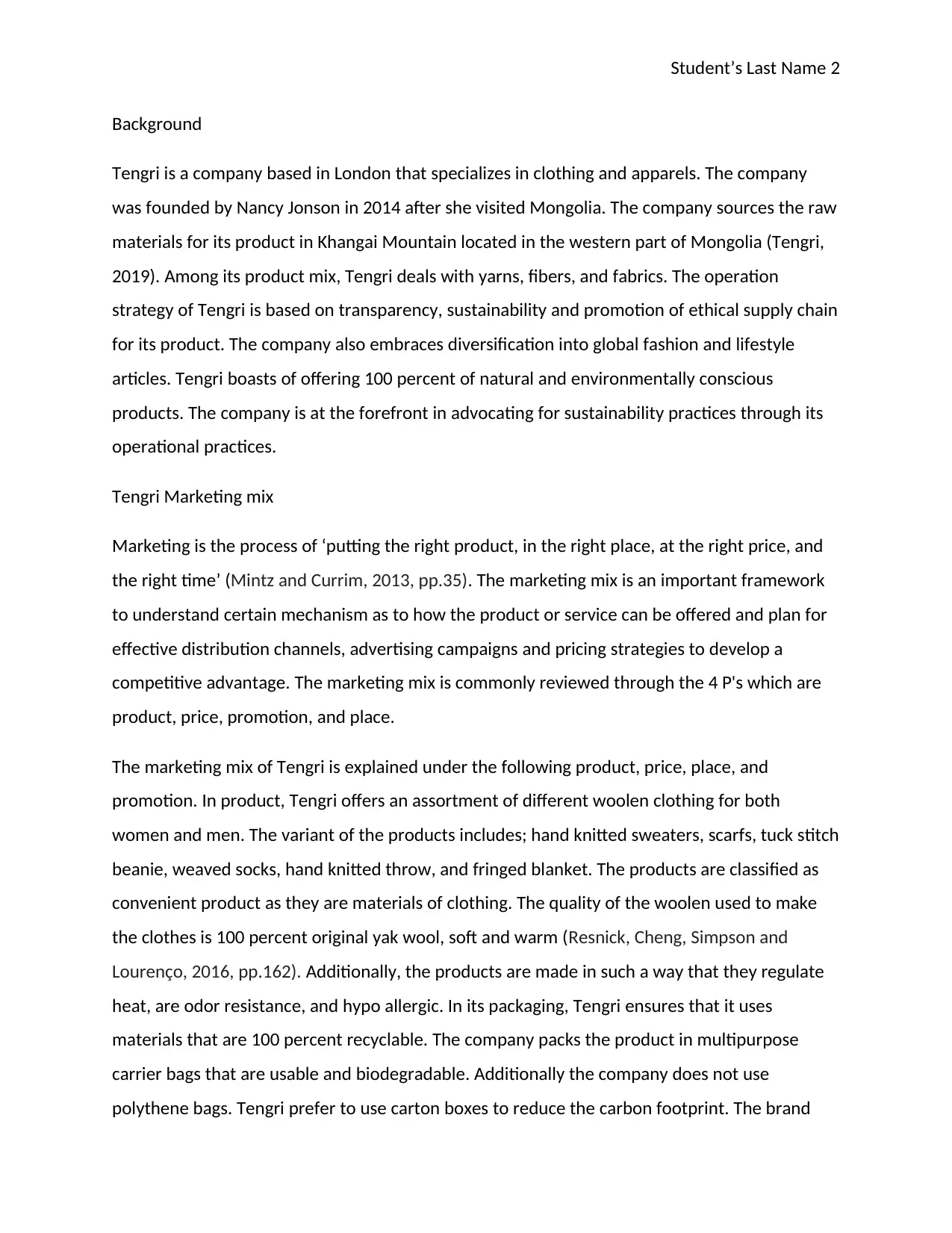
Student’s Last Name 2
Background
Tengri is a company based in London that specializes in clothing and apparels. The company
was founded by Nancy Jonson in 2014 after she visited Mongolia. The company sources the raw
materials for its product in Khangai Mountain located in the western part of Mongolia (Tengri,
2019). Among its product mix, Tengri deals with yarns, fibers, and fabrics. The operation
strategy of Tengri is based on transparency, sustainability and promotion of ethical supply chain
for its product. The company also embraces diversification into global fashion and lifestyle
articles. Tengri boasts of offering 100 percent of natural and environmentally conscious
products. The company is at the forefront in advocating for sustainability practices through its
operational practices.
Tengri Marketing mix
Marketing is the process of ‘putting the right product, in the right place, at the right price, and
the right time’ (Mintz and Currim, 2013, pp.35). The marketing mix is an important framework
to understand certain mechanism as to how the product or service can be offered and plan for
effective distribution channels, advertising campaigns and pricing strategies to develop a
competitive advantage. The marketing mix is commonly reviewed through the 4 P's which are
product, price, promotion, and place.
The marketing mix of Tengri is explained under the following product, price, place, and
promotion. In product, Tengri offers an assortment of different woolen clothing for both
women and men. The variant of the products includes; hand knitted sweaters, scarfs, tuck stitch
beanie, weaved socks, hand knitted throw, and fringed blanket. The products are classified as
convenient product as they are materials of clothing. The quality of the woolen used to make
the clothes is 100 percent original yak wool, soft and warm (Resnick, Cheng, Simpson and
Lourenço, 2016, pp.162). Additionally, the products are made in such a way that they regulate
heat, are odor resistance, and hypo allergic. In its packaging, Tengri ensures that it uses
materials that are 100 percent recyclable. The company packs the product in multipurpose
carrier bags that are usable and biodegradable. Additionally the company does not use
polythene bags. Tengri prefer to use carton boxes to reduce the carbon footprint. The brand
Background
Tengri is a company based in London that specializes in clothing and apparels. The company
was founded by Nancy Jonson in 2014 after she visited Mongolia. The company sources the raw
materials for its product in Khangai Mountain located in the western part of Mongolia (Tengri,
2019). Among its product mix, Tengri deals with yarns, fibers, and fabrics. The operation
strategy of Tengri is based on transparency, sustainability and promotion of ethical supply chain
for its product. The company also embraces diversification into global fashion and lifestyle
articles. Tengri boasts of offering 100 percent of natural and environmentally conscious
products. The company is at the forefront in advocating for sustainability practices through its
operational practices.
Tengri Marketing mix
Marketing is the process of ‘putting the right product, in the right place, at the right price, and
the right time’ (Mintz and Currim, 2013, pp.35). The marketing mix is an important framework
to understand certain mechanism as to how the product or service can be offered and plan for
effective distribution channels, advertising campaigns and pricing strategies to develop a
competitive advantage. The marketing mix is commonly reviewed through the 4 P's which are
product, price, promotion, and place.
The marketing mix of Tengri is explained under the following product, price, place, and
promotion. In product, Tengri offers an assortment of different woolen clothing for both
women and men. The variant of the products includes; hand knitted sweaters, scarfs, tuck stitch
beanie, weaved socks, hand knitted throw, and fringed blanket. The products are classified as
convenient product as they are materials of clothing. The quality of the woolen used to make
the clothes is 100 percent original yak wool, soft and warm (Resnick, Cheng, Simpson and
Lourenço, 2016, pp.162). Additionally, the products are made in such a way that they regulate
heat, are odor resistance, and hypo allergic. In its packaging, Tengri ensures that it uses
materials that are 100 percent recyclable. The company packs the product in multipurpose
carrier bags that are usable and biodegradable. Additionally the company does not use
polythene bags. Tengri prefer to use carton boxes to reduce the carbon footprint. The brand
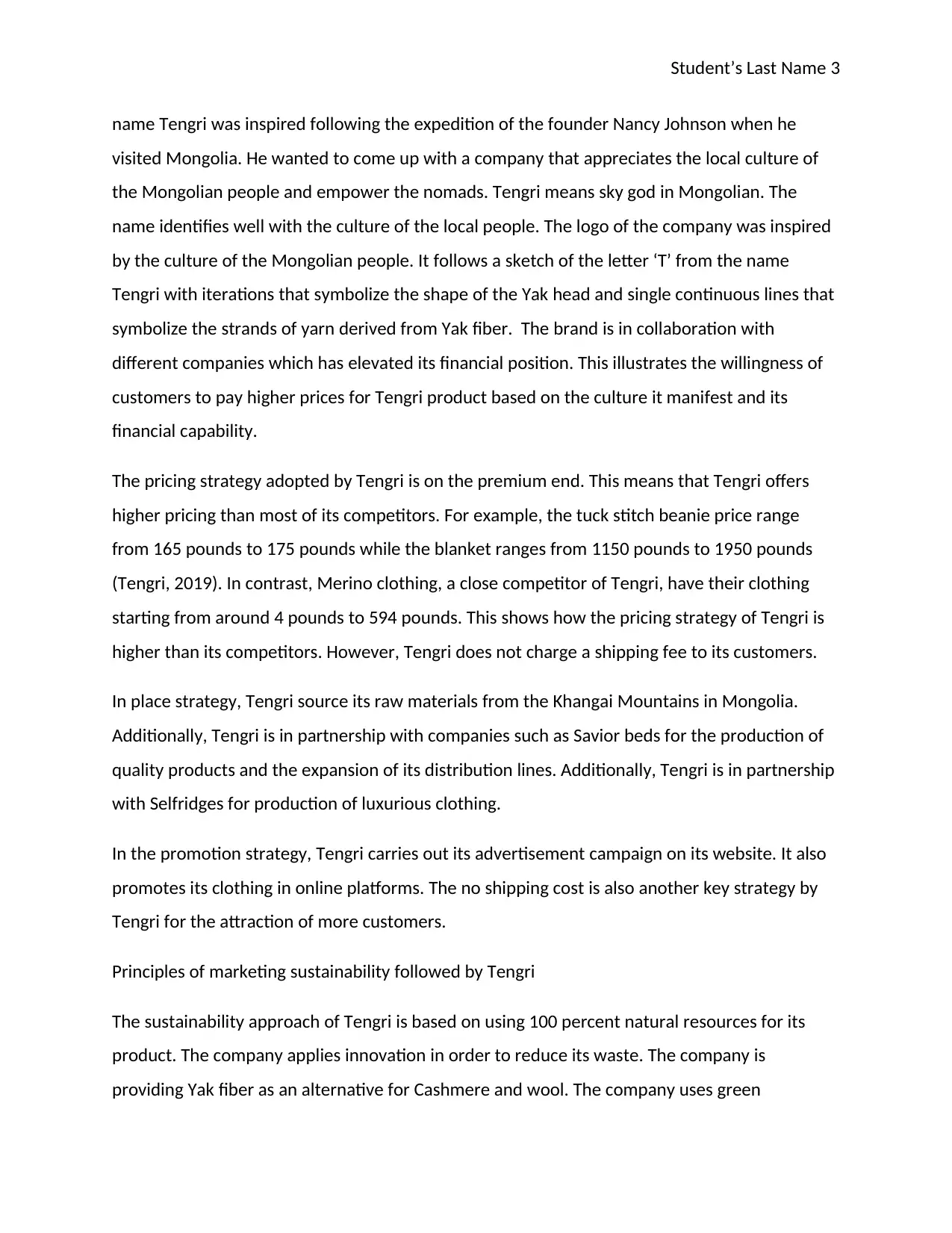
Student’s Last Name 3
name Tengri was inspired following the expedition of the founder Nancy Johnson when he
visited Mongolia. He wanted to come up with a company that appreciates the local culture of
the Mongolian people and empower the nomads. Tengri means sky god in Mongolian. The
name identifies well with the culture of the local people. The logo of the company was inspired
by the culture of the Mongolian people. It follows a sketch of the letter ‘T’ from the name
Tengri with iterations that symbolize the shape of the Yak head and single continuous lines that
symbolize the strands of yarn derived from Yak fiber. The brand is in collaboration with
different companies which has elevated its financial position. This illustrates the willingness of
customers to pay higher prices for Tengri product based on the culture it manifest and its
financial capability.
The pricing strategy adopted by Tengri is on the premium end. This means that Tengri offers
higher pricing than most of its competitors. For example, the tuck stitch beanie price range
from 165 pounds to 175 pounds while the blanket ranges from 1150 pounds to 1950 pounds
(Tengri, 2019). In contrast, Merino clothing, a close competitor of Tengri, have their clothing
starting from around 4 pounds to 594 pounds. This shows how the pricing strategy of Tengri is
higher than its competitors. However, Tengri does not charge a shipping fee to its customers.
In place strategy, Tengri source its raw materials from the Khangai Mountains in Mongolia.
Additionally, Tengri is in partnership with companies such as Savior beds for the production of
quality products and the expansion of its distribution lines. Additionally, Tengri is in partnership
with Selfridges for production of luxurious clothing.
In the promotion strategy, Tengri carries out its advertisement campaign on its website. It also
promotes its clothing in online platforms. The no shipping cost is also another key strategy by
Tengri for the attraction of more customers.
Principles of marketing sustainability followed by Tengri
The sustainability approach of Tengri is based on using 100 percent natural resources for its
product. The company applies innovation in order to reduce its waste. The company is
providing Yak fiber as an alternative for Cashmere and wool. The company uses green
name Tengri was inspired following the expedition of the founder Nancy Johnson when he
visited Mongolia. He wanted to come up with a company that appreciates the local culture of
the Mongolian people and empower the nomads. Tengri means sky god in Mongolian. The
name identifies well with the culture of the local people. The logo of the company was inspired
by the culture of the Mongolian people. It follows a sketch of the letter ‘T’ from the name
Tengri with iterations that symbolize the shape of the Yak head and single continuous lines that
symbolize the strands of yarn derived from Yak fiber. The brand is in collaboration with
different companies which has elevated its financial position. This illustrates the willingness of
customers to pay higher prices for Tengri product based on the culture it manifest and its
financial capability.
The pricing strategy adopted by Tengri is on the premium end. This means that Tengri offers
higher pricing than most of its competitors. For example, the tuck stitch beanie price range
from 165 pounds to 175 pounds while the blanket ranges from 1150 pounds to 1950 pounds
(Tengri, 2019). In contrast, Merino clothing, a close competitor of Tengri, have their clothing
starting from around 4 pounds to 594 pounds. This shows how the pricing strategy of Tengri is
higher than its competitors. However, Tengri does not charge a shipping fee to its customers.
In place strategy, Tengri source its raw materials from the Khangai Mountains in Mongolia.
Additionally, Tengri is in partnership with companies such as Savior beds for the production of
quality products and the expansion of its distribution lines. Additionally, Tengri is in partnership
with Selfridges for production of luxurious clothing.
In the promotion strategy, Tengri carries out its advertisement campaign on its website. It also
promotes its clothing in online platforms. The no shipping cost is also another key strategy by
Tengri for the attraction of more customers.
Principles of marketing sustainability followed by Tengri
The sustainability approach of Tengri is based on using 100 percent natural resources for its
product. The company applies innovation in order to reduce its waste. The company is
providing Yak fiber as an alternative for Cashmere and wool. The company uses green
⊘ This is a preview!⊘
Do you want full access?
Subscribe today to unlock all pages.

Trusted by 1+ million students worldwide
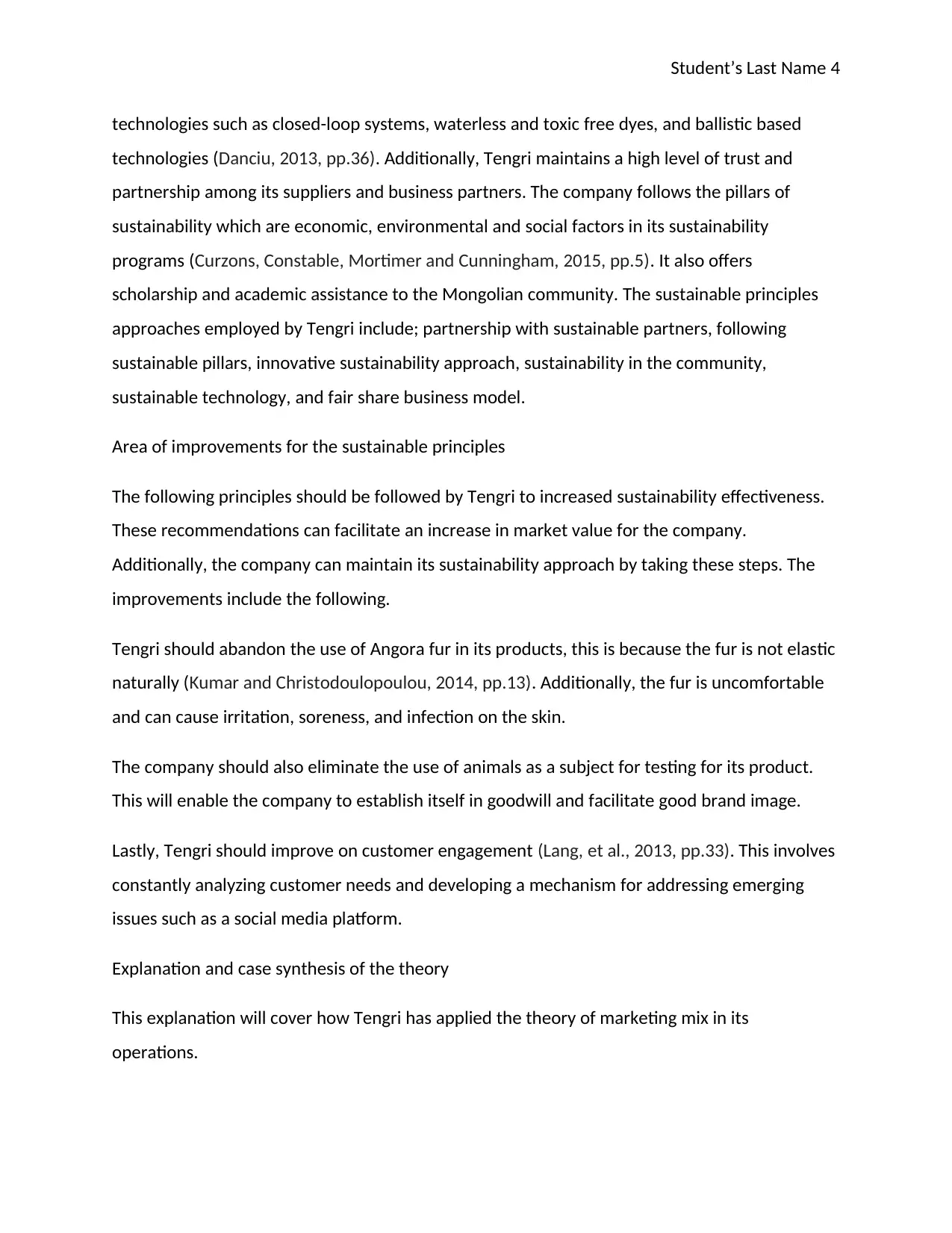
Student’s Last Name 4
technologies such as closed-loop systems, waterless and toxic free dyes, and ballistic based
technologies (Danciu, 2013, pp.36). Additionally, Tengri maintains a high level of trust and
partnership among its suppliers and business partners. The company follows the pillars of
sustainability which are economic, environmental and social factors in its sustainability
programs (Curzons, Constable, Mortimer and Cunningham, 2015, pp.5). It also offers
scholarship and academic assistance to the Mongolian community. The sustainable principles
approaches employed by Tengri include; partnership with sustainable partners, following
sustainable pillars, innovative sustainability approach, sustainability in the community,
sustainable technology, and fair share business model.
Area of improvements for the sustainable principles
The following principles should be followed by Tengri to increased sustainability effectiveness.
These recommendations can facilitate an increase in market value for the company.
Additionally, the company can maintain its sustainability approach by taking these steps. The
improvements include the following.
Tengri should abandon the use of Angora fur in its products, this is because the fur is not elastic
naturally (Kumar and Christodoulopoulou, 2014, pp.13). Additionally, the fur is uncomfortable
and can cause irritation, soreness, and infection on the skin.
The company should also eliminate the use of animals as a subject for testing for its product.
This will enable the company to establish itself in goodwill and facilitate good brand image.
Lastly, Tengri should improve on customer engagement (Lang, et al., 2013, pp.33). This involves
constantly analyzing customer needs and developing a mechanism for addressing emerging
issues such as a social media platform.
Explanation and case synthesis of the theory
This explanation will cover how Tengri has applied the theory of marketing mix in its
operations.
technologies such as closed-loop systems, waterless and toxic free dyes, and ballistic based
technologies (Danciu, 2013, pp.36). Additionally, Tengri maintains a high level of trust and
partnership among its suppliers and business partners. The company follows the pillars of
sustainability which are economic, environmental and social factors in its sustainability
programs (Curzons, Constable, Mortimer and Cunningham, 2015, pp.5). It also offers
scholarship and academic assistance to the Mongolian community. The sustainable principles
approaches employed by Tengri include; partnership with sustainable partners, following
sustainable pillars, innovative sustainability approach, sustainability in the community,
sustainable technology, and fair share business model.
Area of improvements for the sustainable principles
The following principles should be followed by Tengri to increased sustainability effectiveness.
These recommendations can facilitate an increase in market value for the company.
Additionally, the company can maintain its sustainability approach by taking these steps. The
improvements include the following.
Tengri should abandon the use of Angora fur in its products, this is because the fur is not elastic
naturally (Kumar and Christodoulopoulou, 2014, pp.13). Additionally, the fur is uncomfortable
and can cause irritation, soreness, and infection on the skin.
The company should also eliminate the use of animals as a subject for testing for its product.
This will enable the company to establish itself in goodwill and facilitate good brand image.
Lastly, Tengri should improve on customer engagement (Lang, et al., 2013, pp.33). This involves
constantly analyzing customer needs and developing a mechanism for addressing emerging
issues such as a social media platform.
Explanation and case synthesis of the theory
This explanation will cover how Tengri has applied the theory of marketing mix in its
operations.
Paraphrase This Document
Need a fresh take? Get an instant paraphrase of this document with our AI Paraphraser
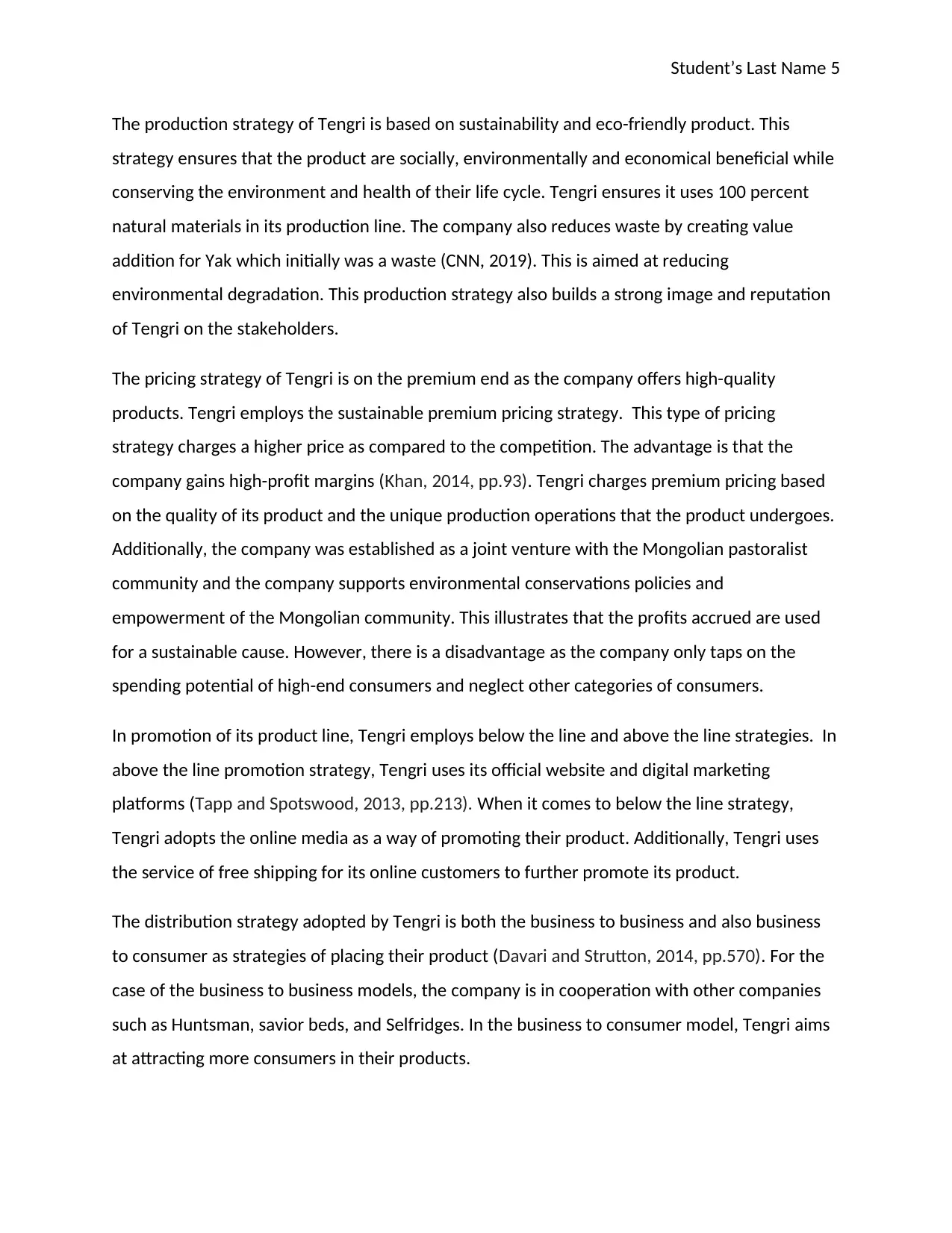
Student’s Last Name 5
The production strategy of Tengri is based on sustainability and eco-friendly product. This
strategy ensures that the product are socially, environmentally and economical beneficial while
conserving the environment and health of their life cycle. Tengri ensures it uses 100 percent
natural materials in its production line. The company also reduces waste by creating value
addition for Yak which initially was a waste (CNN, 2019). This is aimed at reducing
environmental degradation. This production strategy also builds a strong image and reputation
of Tengri on the stakeholders.
The pricing strategy of Tengri is on the premium end as the company offers high-quality
products. Tengri employs the sustainable premium pricing strategy. This type of pricing
strategy charges a higher price as compared to the competition. The advantage is that the
company gains high-profit margins (Khan, 2014, pp.93). Tengri charges premium pricing based
on the quality of its product and the unique production operations that the product undergoes.
Additionally, the company was established as a joint venture with the Mongolian pastoralist
community and the company supports environmental conservations policies and
empowerment of the Mongolian community. This illustrates that the profits accrued are used
for a sustainable cause. However, there is a disadvantage as the company only taps on the
spending potential of high-end consumers and neglect other categories of consumers.
In promotion of its product line, Tengri employs below the line and above the line strategies. In
above the line promotion strategy, Tengri uses its official website and digital marketing
platforms (Tapp and Spotswood, 2013, pp.213). When it comes to below the line strategy,
Tengri adopts the online media as a way of promoting their product. Additionally, Tengri uses
the service of free shipping for its online customers to further promote its product.
The distribution strategy adopted by Tengri is both the business to business and also business
to consumer as strategies of placing their product (Davari and Strutton, 2014, pp.570). For the
case of the business to business models, the company is in cooperation with other companies
such as Huntsman, savior beds, and Selfridges. In the business to consumer model, Tengri aims
at attracting more consumers in their products.
The production strategy of Tengri is based on sustainability and eco-friendly product. This
strategy ensures that the product are socially, environmentally and economical beneficial while
conserving the environment and health of their life cycle. Tengri ensures it uses 100 percent
natural materials in its production line. The company also reduces waste by creating value
addition for Yak which initially was a waste (CNN, 2019). This is aimed at reducing
environmental degradation. This production strategy also builds a strong image and reputation
of Tengri on the stakeholders.
The pricing strategy of Tengri is on the premium end as the company offers high-quality
products. Tengri employs the sustainable premium pricing strategy. This type of pricing
strategy charges a higher price as compared to the competition. The advantage is that the
company gains high-profit margins (Khan, 2014, pp.93). Tengri charges premium pricing based
on the quality of its product and the unique production operations that the product undergoes.
Additionally, the company was established as a joint venture with the Mongolian pastoralist
community and the company supports environmental conservations policies and
empowerment of the Mongolian community. This illustrates that the profits accrued are used
for a sustainable cause. However, there is a disadvantage as the company only taps on the
spending potential of high-end consumers and neglect other categories of consumers.
In promotion of its product line, Tengri employs below the line and above the line strategies. In
above the line promotion strategy, Tengri uses its official website and digital marketing
platforms (Tapp and Spotswood, 2013, pp.213). When it comes to below the line strategy,
Tengri adopts the online media as a way of promoting their product. Additionally, Tengri uses
the service of free shipping for its online customers to further promote its product.
The distribution strategy adopted by Tengri is both the business to business and also business
to consumer as strategies of placing their product (Davari and Strutton, 2014, pp.570). For the
case of the business to business models, the company is in cooperation with other companies
such as Huntsman, savior beds, and Selfridges. In the business to consumer model, Tengri aims
at attracting more consumers in their products.
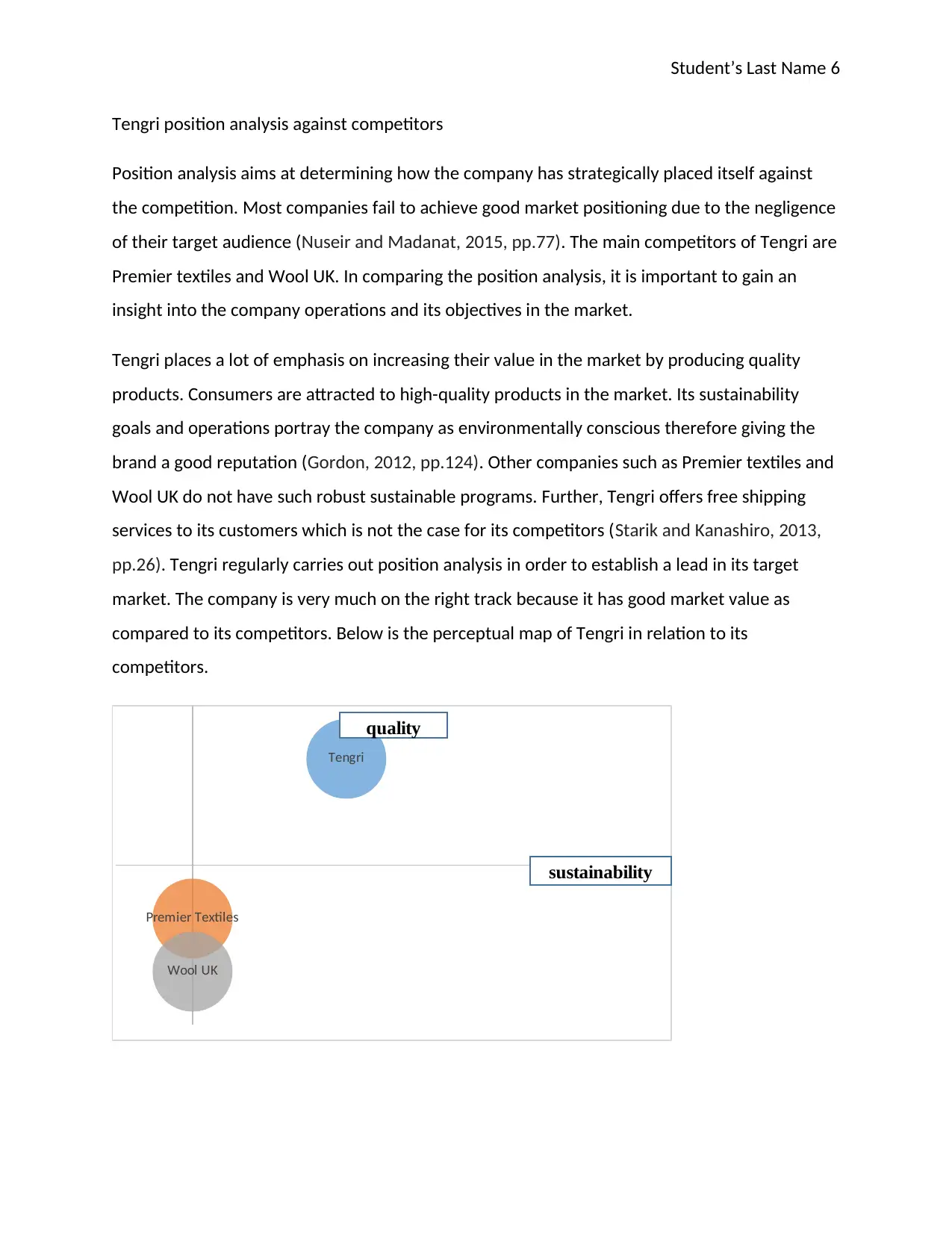
Student’s Last Name 6
Tengri position analysis against competitors
Position analysis aims at determining how the company has strategically placed itself against
the competition. Most companies fail to achieve good market positioning due to the negligence
of their target audience (Nuseir and Madanat, 2015, pp.77). The main competitors of Tengri are
Premier textiles and Wool UK. In comparing the position analysis, it is important to gain an
insight into the company operations and its objectives in the market.
Tengri places a lot of emphasis on increasing their value in the market by producing quality
products. Consumers are attracted to high-quality products in the market. Its sustainability
goals and operations portray the company as environmentally conscious therefore giving the
brand a good reputation (Gordon, 2012, pp.124). Other companies such as Premier textiles and
Wool UK do not have such robust sustainable programs. Further, Tengri offers free shipping
services to its customers which is not the case for its competitors (Starik and Kanashiro, 2013,
pp.26). Tengri regularly carries out position analysis in order to establish a lead in its target
market. The company is very much on the right track because it has good market value as
compared to its competitors. Below is the perceptual map of Tengri in relation to its
competitors.
Tengri
Premier Textiles
Wool UK
sustainability
quality
Tengri position analysis against competitors
Position analysis aims at determining how the company has strategically placed itself against
the competition. Most companies fail to achieve good market positioning due to the negligence
of their target audience (Nuseir and Madanat, 2015, pp.77). The main competitors of Tengri are
Premier textiles and Wool UK. In comparing the position analysis, it is important to gain an
insight into the company operations and its objectives in the market.
Tengri places a lot of emphasis on increasing their value in the market by producing quality
products. Consumers are attracted to high-quality products in the market. Its sustainability
goals and operations portray the company as environmentally conscious therefore giving the
brand a good reputation (Gordon, 2012, pp.124). Other companies such as Premier textiles and
Wool UK do not have such robust sustainable programs. Further, Tengri offers free shipping
services to its customers which is not the case for its competitors (Starik and Kanashiro, 2013,
pp.26). Tengri regularly carries out position analysis in order to establish a lead in its target
market. The company is very much on the right track because it has good market value as
compared to its competitors. Below is the perceptual map of Tengri in relation to its
competitors.
Tengri
Premier Textiles
Wool UK
sustainability
quality
⊘ This is a preview!⊘
Do you want full access?
Subscribe today to unlock all pages.

Trusted by 1+ million students worldwide
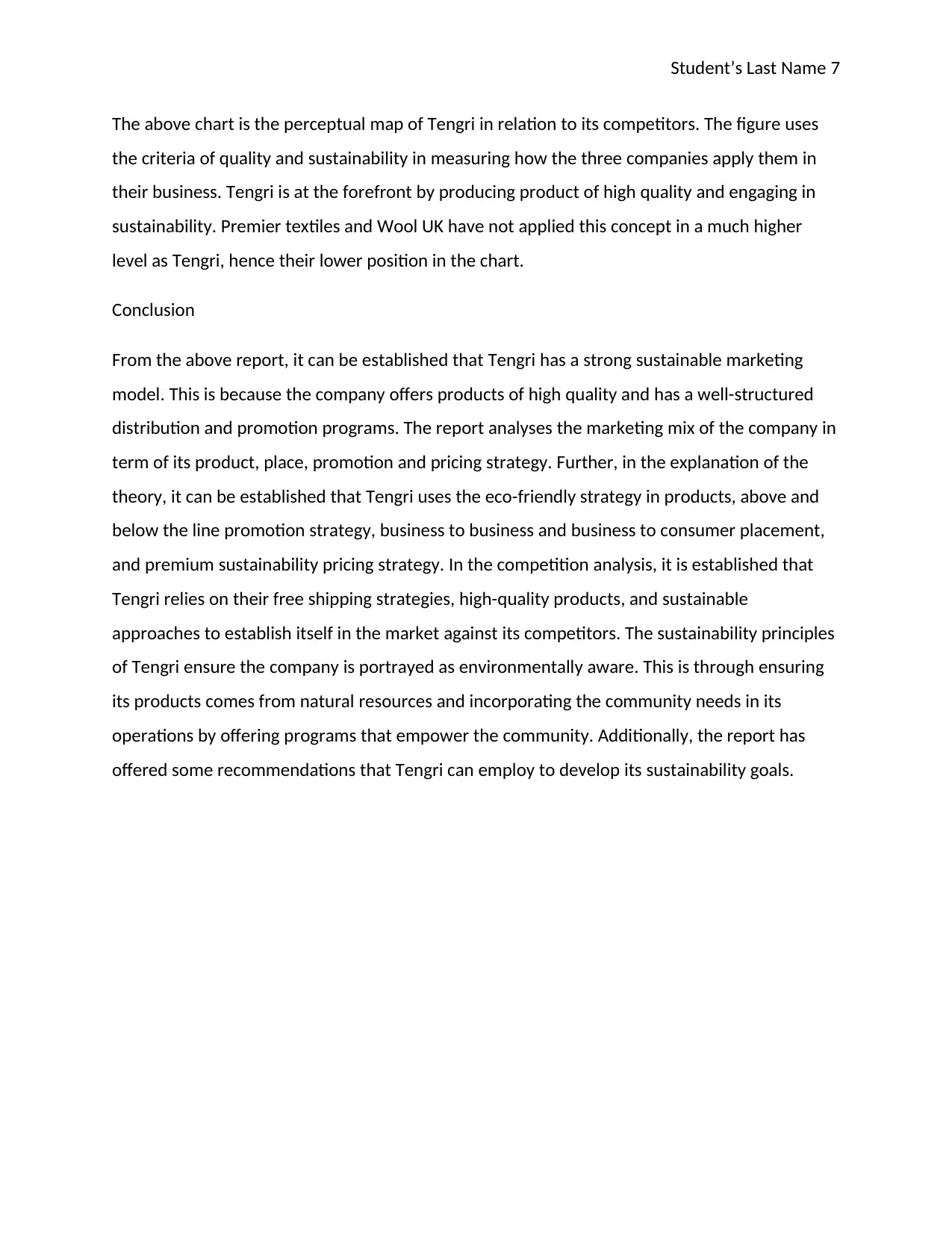
Student’s Last Name 7
The above chart is the perceptual map of Tengri in relation to its competitors. The figure uses
the criteria of quality and sustainability in measuring how the three companies apply them in
their business. Tengri is at the forefront by producing product of high quality and engaging in
sustainability. Premier textiles and Wool UK have not applied this concept in a much higher
level as Tengri, hence their lower position in the chart.
Conclusion
From the above report, it can be established that Tengri has a strong sustainable marketing
model. This is because the company offers products of high quality and has a well-structured
distribution and promotion programs. The report analyses the marketing mix of the company in
term of its product, place, promotion and pricing strategy. Further, in the explanation of the
theory, it can be established that Tengri uses the eco-friendly strategy in products, above and
below the line promotion strategy, business to business and business to consumer placement,
and premium sustainability pricing strategy. In the competition analysis, it is established that
Tengri relies on their free shipping strategies, high-quality products, and sustainable
approaches to establish itself in the market against its competitors. The sustainability principles
of Tengri ensure the company is portrayed as environmentally aware. This is through ensuring
its products comes from natural resources and incorporating the community needs in its
operations by offering programs that empower the community. Additionally, the report has
offered some recommendations that Tengri can employ to develop its sustainability goals.
The above chart is the perceptual map of Tengri in relation to its competitors. The figure uses
the criteria of quality and sustainability in measuring how the three companies apply them in
their business. Tengri is at the forefront by producing product of high quality and engaging in
sustainability. Premier textiles and Wool UK have not applied this concept in a much higher
level as Tengri, hence their lower position in the chart.
Conclusion
From the above report, it can be established that Tengri has a strong sustainable marketing
model. This is because the company offers products of high quality and has a well-structured
distribution and promotion programs. The report analyses the marketing mix of the company in
term of its product, place, promotion and pricing strategy. Further, in the explanation of the
theory, it can be established that Tengri uses the eco-friendly strategy in products, above and
below the line promotion strategy, business to business and business to consumer placement,
and premium sustainability pricing strategy. In the competition analysis, it is established that
Tengri relies on their free shipping strategies, high-quality products, and sustainable
approaches to establish itself in the market against its competitors. The sustainability principles
of Tengri ensure the company is portrayed as environmentally aware. This is through ensuring
its products comes from natural resources and incorporating the community needs in its
operations by offering programs that empower the community. Additionally, the report has
offered some recommendations that Tengri can employ to develop its sustainability goals.
Paraphrase This Document
Need a fresh take? Get an instant paraphrase of this document with our AI Paraphraser
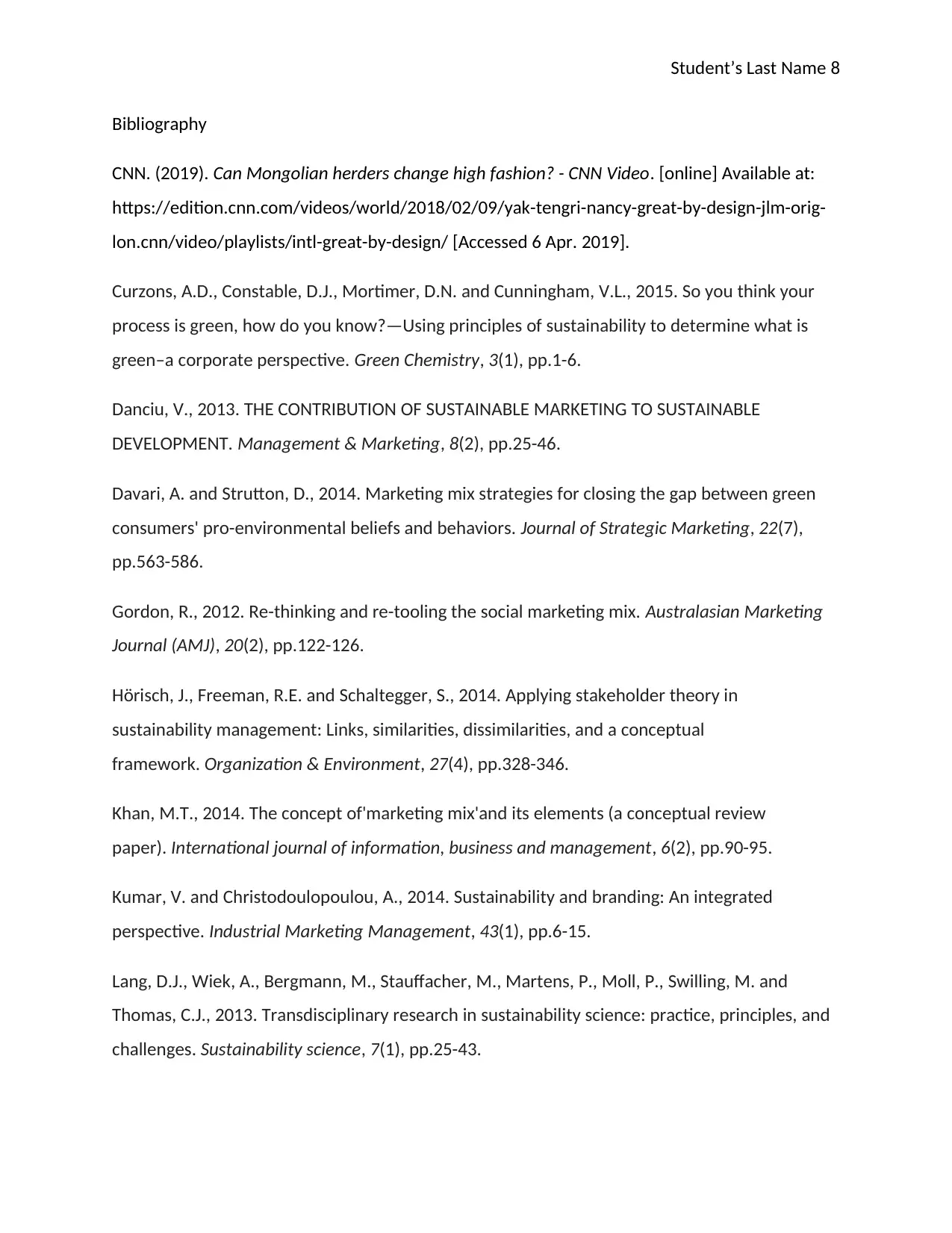
Student’s Last Name 8
Bibliography
CNN. (2019). Can Mongolian herders change high fashion? - CNN Video. [online] Available at:
https://edition.cnn.com/videos/world/2018/02/09/yak-tengri-nancy-great-by-design-jlm-orig-
lon.cnn/video/playlists/intl-great-by-design/ [Accessed 6 Apr. 2019].
Curzons, A.D., Constable, D.J., Mortimer, D.N. and Cunningham, V.L., 2015. So you think your
process is green, how do you know?—Using principles of sustainability to determine what is
green–a corporate perspective. Green Chemistry, 3(1), pp.1-6.
Danciu, V., 2013. THE CONTRIBUTION OF SUSTAINABLE MARKETING TO SUSTAINABLE
DEVELOPMENT. Management & Marketing, 8(2), pp.25-46.
Davari, A. and Strutton, D., 2014. Marketing mix strategies for closing the gap between green
consumers' pro-environmental beliefs and behaviors. Journal of Strategic Marketing, 22(7),
pp.563-586.
Gordon, R., 2012. Re-thinking and re-tooling the social marketing mix. Australasian Marketing
Journal (AMJ), 20(2), pp.122-126.
Hörisch, J., Freeman, R.E. and Schaltegger, S., 2014. Applying stakeholder theory in
sustainability management: Links, similarities, dissimilarities, and a conceptual
framework. Organization & Environment, 27(4), pp.328-346.
Khan, M.T., 2014. The concept of'marketing mix'and its elements (a conceptual review
paper). International journal of information, business and management, 6(2), pp.90-95.
Kumar, V. and Christodoulopoulou, A., 2014. Sustainability and branding: An integrated
perspective. Industrial Marketing Management, 43(1), pp.6-15.
Lang, D.J., Wiek, A., Bergmann, M., Stauffacher, M., Martens, P., Moll, P., Swilling, M. and
Thomas, C.J., 2013. Transdisciplinary research in sustainability science: practice, principles, and
challenges. Sustainability science, 7(1), pp.25-43.
Bibliography
CNN. (2019). Can Mongolian herders change high fashion? - CNN Video. [online] Available at:
https://edition.cnn.com/videos/world/2018/02/09/yak-tengri-nancy-great-by-design-jlm-orig-
lon.cnn/video/playlists/intl-great-by-design/ [Accessed 6 Apr. 2019].
Curzons, A.D., Constable, D.J., Mortimer, D.N. and Cunningham, V.L., 2015. So you think your
process is green, how do you know?—Using principles of sustainability to determine what is
green–a corporate perspective. Green Chemistry, 3(1), pp.1-6.
Danciu, V., 2013. THE CONTRIBUTION OF SUSTAINABLE MARKETING TO SUSTAINABLE
DEVELOPMENT. Management & Marketing, 8(2), pp.25-46.
Davari, A. and Strutton, D., 2014. Marketing mix strategies for closing the gap between green
consumers' pro-environmental beliefs and behaviors. Journal of Strategic Marketing, 22(7),
pp.563-586.
Gordon, R., 2012. Re-thinking and re-tooling the social marketing mix. Australasian Marketing
Journal (AMJ), 20(2), pp.122-126.
Hörisch, J., Freeman, R.E. and Schaltegger, S., 2014. Applying stakeholder theory in
sustainability management: Links, similarities, dissimilarities, and a conceptual
framework. Organization & Environment, 27(4), pp.328-346.
Khan, M.T., 2014. The concept of'marketing mix'and its elements (a conceptual review
paper). International journal of information, business and management, 6(2), pp.90-95.
Kumar, V. and Christodoulopoulou, A., 2014. Sustainability and branding: An integrated
perspective. Industrial Marketing Management, 43(1), pp.6-15.
Lang, D.J., Wiek, A., Bergmann, M., Stauffacher, M., Martens, P., Moll, P., Swilling, M. and
Thomas, C.J., 2013. Transdisciplinary research in sustainability science: practice, principles, and
challenges. Sustainability science, 7(1), pp.25-43.
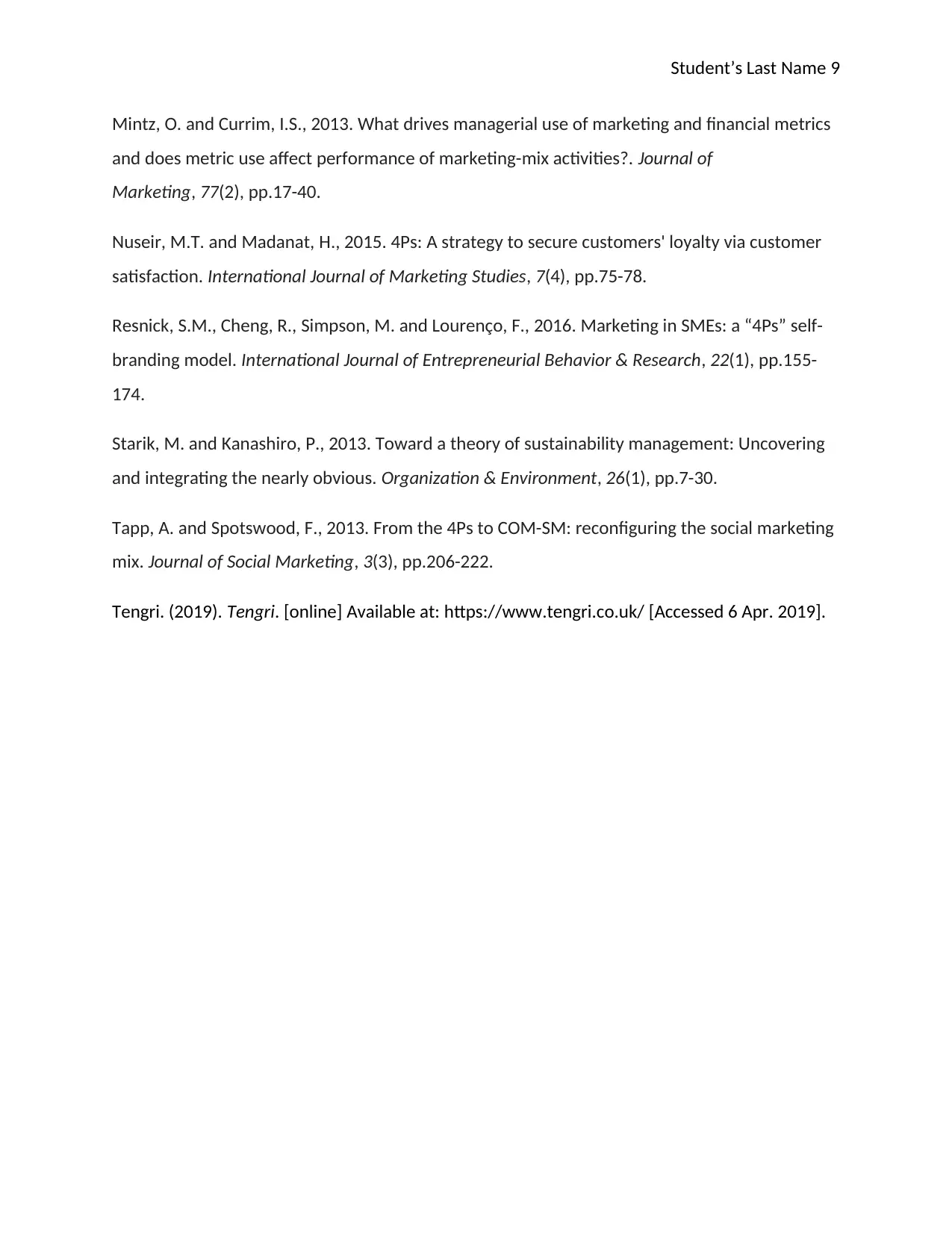
Student’s Last Name 9
Mintz, O. and Currim, I.S., 2013. What drives managerial use of marketing and financial metrics
and does metric use affect performance of marketing-mix activities?. Journal of
Marketing, 77(2), pp.17-40.
Nuseir, M.T. and Madanat, H., 2015. 4Ps: A strategy to secure customers' loyalty via customer
satisfaction. International Journal of Marketing Studies, 7(4), pp.75-78.
Resnick, S.M., Cheng, R., Simpson, M. and Lourenço, F., 2016. Marketing in SMEs: a “4Ps” self-
branding model. International Journal of Entrepreneurial Behavior & Research, 22(1), pp.155-
174.
Starik, M. and Kanashiro, P., 2013. Toward a theory of sustainability management: Uncovering
and integrating the nearly obvious. Organization & Environment, 26(1), pp.7-30.
Tapp, A. and Spotswood, F., 2013. From the 4Ps to COM-SM: reconfiguring the social marketing
mix. Journal of Social Marketing, 3(3), pp.206-222.
Tengri. (2019). Tengri. [online] Available at: https://www.tengri.co.uk/ [Accessed 6 Apr. 2019].
Mintz, O. and Currim, I.S., 2013. What drives managerial use of marketing and financial metrics
and does metric use affect performance of marketing-mix activities?. Journal of
Marketing, 77(2), pp.17-40.
Nuseir, M.T. and Madanat, H., 2015. 4Ps: A strategy to secure customers' loyalty via customer
satisfaction. International Journal of Marketing Studies, 7(4), pp.75-78.
Resnick, S.M., Cheng, R., Simpson, M. and Lourenço, F., 2016. Marketing in SMEs: a “4Ps” self-
branding model. International Journal of Entrepreneurial Behavior & Research, 22(1), pp.155-
174.
Starik, M. and Kanashiro, P., 2013. Toward a theory of sustainability management: Uncovering
and integrating the nearly obvious. Organization & Environment, 26(1), pp.7-30.
Tapp, A. and Spotswood, F., 2013. From the 4Ps to COM-SM: reconfiguring the social marketing
mix. Journal of Social Marketing, 3(3), pp.206-222.
Tengri. (2019). Tengri. [online] Available at: https://www.tengri.co.uk/ [Accessed 6 Apr. 2019].
⊘ This is a preview!⊘
Do you want full access?
Subscribe today to unlock all pages.

Trusted by 1+ million students worldwide
1 out of 9
Related Documents
Your All-in-One AI-Powered Toolkit for Academic Success.
+13062052269
info@desklib.com
Available 24*7 on WhatsApp / Email
![[object Object]](/_next/static/media/star-bottom.7253800d.svg)
Unlock your academic potential
Copyright © 2020–2025 A2Z Services. All Rights Reserved. Developed and managed by ZUCOL.




